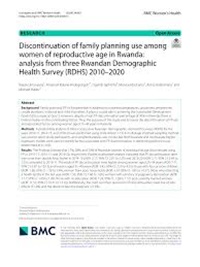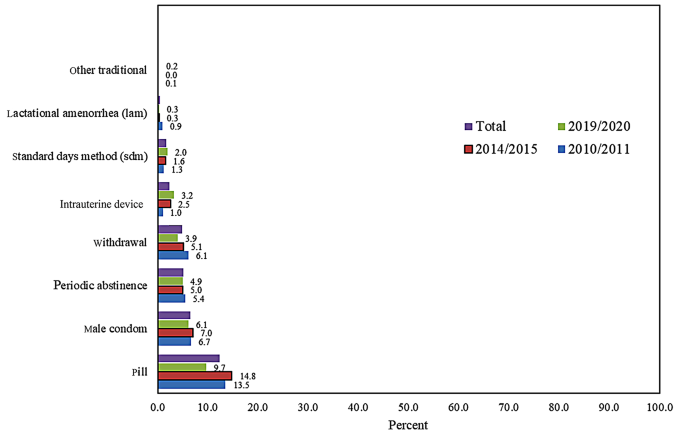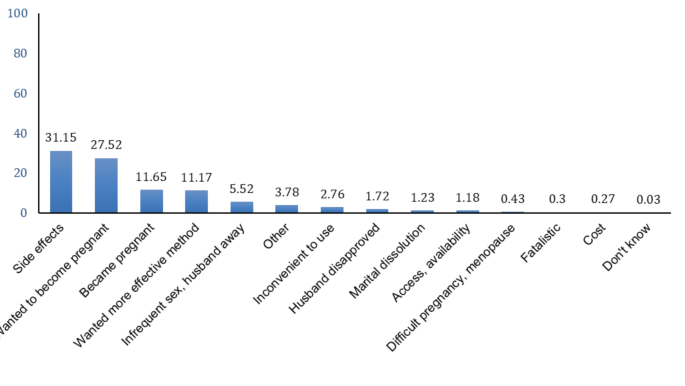Abstract
Background
Family planning (FP) is fundamental in addressing unwanted pregnancies, unplanned pregnancies, unsafe abortions, maternal and child mortalities. It plays a crucial role in achieving the Sustainable Development Goals (SDGs), especial Goal 3. However, despite a high FP discontinuation percentage of 30% in Rwanda, there is limited studies on the contributing factors. Thus, the purpose of this study was to assess the discontinuation of FP use and associated factors among women aged 15–49 years in Rwanda.
Methods
A pooled data analysis of three consecutive Rwandan Demographic and Health Surveys (RDHS) for the years 2010-11, 2014-15, and 2019-20 was performed using Stata Version 17.0. A multistage stratified sampling method was used to select study participants, and weighted analysis was conducted. Both bivariate and multivariate logistic regression models were used to identify factors associated with FP discontinuation. A statistical significance was determined at p < 0.05.

Results
The findings showed that 17%, 28%, and 29% of Rwandan women of reproductive age discontinued using FP in 2010-11, 2014-15, and 2019-20, respectively. Pooled multivariate analysis indicated that FP discontinuation rates was more than double folds higher in 2014-15 (AOR: 2.17; 95% CI: 2.01 to 2.35) and 2019-20 (AOR: 2.71; 95% CI: 2.49 to 2.93) compared to 2010-11. The odds of FP discontinuation were higher among women aged 20–34 years (AOR: 7.71; 95% CI: 5.87 to 10.13) and women aged 35–49 years (AOR: 3.43; 95% CI: 2.59 to 4.55); those with four or more children (AOR: 1.38; 95% CI: 1.28 to 1.49); women from poor households (AOR: 5.19; 95% CI: 1.85 to 14.57); those who attending a health facility in the last year (AOR: 1.56; 95% CI: 1.46 to 1.66); women with a history of pregnancy termination (AOR: 1.17; 95% CI: 1.09 to 1.26); those with no education (AOR: 1.39; 95% CI: 1.28 to 1.51) and currently married women (AOR: 11.57; 95% CI: 10.21 to 13.10). Additionally, the most common reasons for FP discontinuation were fear of side effects (31.2%) and the desire to become pregnant (27.5%).
Conclusions
The trend of FP discontinuation among reproductive-age women in Rwanda has significantly increased from 200 − 11 to 2019-20. Key contributing factors include region, older age, higher parity, poor household status, health facility attendance, history of pregnancy termination, lack of education, being married and fear of side effects. Therefore, interventions should focus on addressing these factors to reduce FP discontinuation rates.
Background
Family planning (FP) is essential for achieving the Sustainable Development Goals (SDGs) [1] and has been identified as a key tool for enhancing the lives of women and infants. Ahmed et al.’s study found that FP could reduce maternal mortality by 32% by enabling women to delay motherhood, space births, and avoid unintended pregnancies and abortions [2]. Additionally, FP has been shown to enhance economic security by increasing incomes, wealth accumulation, and educational attainment for families, households, and communities [3, 4]. Investing in FP also reduces expenditure on maternal and infant mortality and morbidity for both the government and families [5, 6]. Generally, there are two types of FP/contraceptive methods: modern and traditional [5]. Traditional methods include periodic abstinence and withdrawal, while modern methods consists of condoms, sterilization, pills, intrauterine devices, injectables, standard days method, implants and lactational amenorrhea [6].
Despite the significant progress in FP usage, a substantial number of women are discontinuing their FP methods. FP discontinuation refers to starting any contraceptive method and then stopping its use within 12 months without switching to an alternative method [7]. Jain and Winfrey’s study highlighted that about 25 million of the 75 million unintended births in developing countries were due to FP discontinuation [8]. Studies using DHS data reported that 20–50% of FP users discontinued within the first 12 months [9,10,11]. A more recent study on oral contraceptive use in 19 countries showed that 35% of women discontinued its use within 3 months [12]. A WHO report covering 36 countries indicated that two-thirds of sexually active women who wished to delay or limit pregnancy discontinued FP due to fear of side effects, resulting in one in four unintended pregnancies [13, 14]. Furthermore, a study in six African countries found that over 80% of women with unintended pregnancies had not used any FP method. Among traditional method users, 83.8% discontinued due to method failure, while among modern method users, 40.2% discontinued due to side effects [14].
According to Sully et al. out of 316 million women of reproductive age in Africa, 139 million wish to avoid pregnancy [15]. Around 58 million women in African do not use any method of FP and 81% of all unintended pregnancies in African Union member states occur among women who have an unmet need for FP [16]. Discontinuation of modern contraception while in need has been reported more common in sub-Saharan Africa [17]. Despite efforts by East African Community Member States to strengthen FP in the health sector to regulate family size, one in three women in the region still do not use any contraceptive method. Additionally, 46% discontinue FP use resulting in 14 million unintended pregnancies annually in the region [18, 19].
In Rwanda, the DHS survey indicated that the average number of children per woman slightly decreased from 4.2 in 2014-15 to 4.1 in 2019-20 [20]. This minimal decline suggests that the projected UN target of 2.4 children per women in 2050 in Rwanda may not be achieved at this rate [21]. One possible reason for this slow progress could be the high rate of FP discontinuation, with about 30% of women discontinuing FP in the first year of use [20]. Furthermore, a national study conducted by Rugigana et al. [22] found that 74.6% of women aged 15 to 49 years who had ever used FP had discontinued its use at some point in their lives. However, despite a high FP discontinuation rate, there are limited studies on the contributing factors in Rwanda. Therefore, the purpose of this study was to assess FP discontinuation and its associated factors among women of reproductive age in Rwanda, utilizing secondary pooled data analysis from RHDS of 2010-11, 2014-15, and 2019-20.
Methods
Study design
A cross-sectional analytical design was used to investigate the factors associated with FP discontinuation among women aged 15–49 years in Rwanda. This study analyzed data from 2010 to 11, 2014-15 and 2019-20 RDHS surveys. These nationally representative surveys were conducted by the National Institute of Statistics of Rwanda (NISR) in collaboration with government institutions such as the Ministry of Health and the Rwanda Biomedical Center, as well as international partners like the UN, USAID, CDC, UNICEF and UNFPA.
Sampling procedure and sample size
The analysis focused on all women of reproductive age (15 to 49 years) interviewed in the last three surveys. The RDHS employed a multistage stratified sampling technique with two main stages: the first involving a primary sampling units and the second involving selection of households and individuals. Stratification was achieved by dividing each district into urban and rural areas, each forming a separate sampling stratum. After cleaning the data, the final samples included13659 women in 2010-11, 13,491 women in 2014-15, and 14,634 women in 2019-20.
Study variables and measurement
Dependent variable
The outcome variable for this study was contraceptive discontinuation (yes/no) among reproductive-age women (15–49 years). It was defined as the percentage of these women who had used a method of contraception in the last 12 months prior to the survey but were not using any method at the time of data collection [23].
Independent variables
Demographic characteristics of the women
These include maternal age, marital status, place of residence, region, number of children ever born.
Socioeconomic factors
The key variables under this category were level of education, work status, husband’s level of education, household wealth index (based on DHS wealth index as poor, middle and rich).
Awareness and source of FP information
Refer to having ever heard and hearing FP on the radio or Television or newspapers.
Behavioral and reproductive related factors
These factors include history of terminated pregnancy, desire for last child, visited health facility in the last 12 months, discussed about FP with healthcare worker, and fertility preference (number of living children compared with the number of desired children and if the desire is more than the living children then it is considered want more children).
Women’s empowerment indicator
Women participation in decision-making for using FP, which was categorized as mainly by women themselves, husband/partner and joint decision.
Data management
The DHS data is stored on an Integrated System for Survey Analysis (ISSA), a software package specifically developed for this purpose. This software is used for hierarchical data entry and the computation of sampling error in complex survey designs. One of the primary goals of DHS initiative is to enhance data usage for further analysis and exploration, allowing for the discovery of detailed information.
Data analysis
Data were extracted from the women’s file and cleaned. Three consecutive RDHS surveys 2010-11, 2014-15 and 2019-20) were used for analysis. Sampling weight was assigned at various levels to account for over-and under-sampling in some areas, while the svy command (v005/1000000) was used to address the complex sampling procedure. Frequencies and percentages were calculated for categorical variables. Both bivariate and multivariate logistic regression models were employed. A multicollinearity check revealed one variable with a Variance Inflation Factor (VIF) > 5 (Heard about FP in Newspaper/magazine), which was excluded from the multivariate analysis. Crude odds ratios (OR) and adjusted odds ratios (AOR) with 95% confidence intervals (CI) were estimated. Data processing, coding, and analysis were conducted using Stata Version 17.0, with p < 0.05 indicating statistical significance.
Results
Distribution of socio demographic, socio-economic, behavioral and reproductive related factors and pattern of FP discontinuation
The findings indicate that 17%, 28%, and 29% of women of reproductive age have discontinued FP in 2010-11, 2014-15, and 2019-20 respectively. The age distribution was similar across the three surveys, with about 50% in the age range of 20–34 years. Similarly, women with less than three number of children were comparable in the three surveys. Women’s secondary educational attainment has increased from 16% in 2010-11 to 32% in 2019-20 while no education has decreased from 16% in 2010-11 to 9% in 2019-20. The percentage of women who formerly married has declined from 11% in 2010-11 to 9% in 2019-20 (Table 1).
Percentage of not-working women increased from 27% in 2010-11 to 34% in 2019-20. Household wealth index distribution was comparable across the three surveys. In 2019-20, about 70% of women heard about FP from health facility, while this was only 49% in 2010-11. Similarly, the percentage of women who received information about FP from Television increased from 5 to 11% and the use of any type of FP has increased from 29 to 39% between 2010 and 11 and 2019-20, respectively. Women’s participation in the decision-making regarding FP has increased from 8 to 10% during the same time period (Table 1).
Types of FP methods discontinued by year of DHS survey in Rwanda
Pills were the most frequent discontinued method in the three different DHSs in Rwanda followed by male condom and periodic abstinence (Fig. 1). Furthermore, withdrawal was the fourth ranked practice on FP discontinuation among women of reproductive age.
Factors associated with FP discontinuation among women of reproductive age in Rwanda
A significant variation on FP discontinuation and year of DHS survey was observed. Similarly, FP discontinuation was significantly higher among women aged 20 years and above. Number children ever born ( > = 4), no schooling, currently married, from rural place of residence, from the south, north and eastern province of Rwanda, from poor and middle wealth index, who visited health facility 12 months prior to the study, and wanting to have more children were significantly associated with FP discontinuation (Table 2).
Bivariate and multivariate analysis of predicting variables of FP discontinuation among women of reproductive age in Rwanda
After adjusting for potential confounders, the odds of FP discontinuation were more than two folds in 2014-15 (AOR: 2.17; 95% CI: 2.01 to 2.35) and 2019-20 (AOR: 2.71; 95% CI: 2.49 to 2.93) than in 2010-11. Compared to women aged 15 to 19 years, the odds of discontinuation were about 8 folds (AOR: 7.71; 95% CI: 5.87 to 10.13) more among women aged 20 to 34 years. Furthermore, odds of FP discontinuation were 1.38 times more among women with four or more ever born children (AOR: 1.38; 95% CI: 1.28 to 1.49) as compared to less than three ever born children. The odds of FP discontinuation were 11.57 times more (AOR: 11.57; 95% CI: 10.21 to 13.10) among currently married and 4.78 times more among formerly married (AOR: 4.78; 95% CI: 4.12 to 5.53) compared to never married women. Compared to women from Western region of Rwanda, women from Kigali, South, North, and East were significantly more likely to discontinue FP. Women from poor household category were 1.13 times (AOR: 1.13; 95% CI: 1.05 to 1.21) more likely to discontinue FP than those from rich category. Women who visited health facility 12 months preceding the survey were 1.56 times (AOR: 1.56; 95% CI: 1.46 to 1.66) more likely to discontinue FP. Women who had history of terminating pregnancy were 1.17 times (AOR: 1.17; 95% CI: 1.09 to 1.26) more likely to discontinue FP. Moreover, working women, hearing about FP on radio, and wants to have more children were independently associated with FP discontinuation (Table 3).
Reasons for FP discontinuation among women of reproductive age in Rwanda
The primary reasons cited for discontinuing FP were fear of side effects (31.15%) and desire to become pregnant (27.52%) (Fig. 2).
Discussion
This study was aimed to assess the prevalence of FP discontinuation and associated factors among reproductive-age women in Rwanda using RDHS surveys from 2010 to 2020. The finding indicates that the proportion of women who discontinued FP was 17% in 2010-11, 28% in 2014-15, and 29% in 2019-20. These findings are below the global average projected for 2005–2010, where approximately 38% of women using contraceptive methods discontinue their use in the twelve months prior to the survey [17]. However, these findings were higher than a comparable study in Uganda, which reported 5.6% [24]. At the same time FP discontinuation prevalence in the present analysis of three DHS survey was much lower than a similar study among DHS survey of women in Papua New Guinea, which was found 56.18% [25]. This significant disparity may be attributed to the varying levels of unmet need among women in Papua New Guinea compared to those in Rwanda. The unmet needs are causing millions of current family planning users to potentially discontinue in the future. To address this, further initiatives are necessary to help past users with unmet needs resume usage and to encourage current users to continue using the same or alternative methods. This strategy could effectively reduce future discontinuation rates [11].
In the three RDHS surveys in Rwanda, pills were the most frequently discontinued method by the majority of women: 13.5% in 2010-11, 14.8% in 2014-15, and 9.7% in 2019–2020.This was followed by male condoms and periodic abstinence with discontinuation rates of 6.7% in 2010-11, 7.0% in 2014-15, and 6.1% in 2019-20. This findings align with previous research, which indicates that various factors influence the discontinuation of contraceptive methods among women [26, 27]. These factors include limited access to contraception, a limited choice of methods, fear or experience of side-effects, cultural or religious opposition and poor-quality services.
Regarding to reasons for discontinuation, 31.15% women cited fear of side effects, while 27.52% wished to become pregnant. In total, 11.65% and 11.17% of respondents in this study stopped using FP methods due to the belief that they had become pregnant and the availability of more effective alternatives, respectively. This is consistent with previous studies in Rwanda and 36 other low and middle income countries [14, 28]. Additionally, over 5% of women discontinued using FP methods due to infrequent sex, or the absence of their husbands. Furthermore, 2.76% of all respondents stopped using FP because they found the methods inconvenient [28].
A minor variation was observed across different residences and regions in Rwanda. The highest rate of FP discontinuation was recorded in the Eastern province over three consecutive RDHS surveys: 24% in 2010/2011, 25% in 2014/2015, and 27% in 2019/2020. Women from Western region, Kigali, South, North, and East were 1.33 times, 1.32 times, 1.30 times, and 1.27 times more likely to discontinue FP compared to women from the West (p < 0.001) after adjustments. This trend aligns with findings from South Africa and Nigeria, where a significant regional differences were also observed [11, 18]. The disparity in discontinuation rates could be concerned for women in Kigali and the Northern regions, potentially due to lower levels of education and autonomy among women in these areas of Rwanda [23].
Our finding also indicated a significant association between health facility attendance 12 months preceding the survey and FP discontinuation. This may be attributed to factors such as side effects and health concerns related to FP, the quality of counseling received, access and availability of service, and issues in service delivery. Factors like long waiting times, unfriendly staff, or a lack of privacy at health facilities can discourage women from continuing to use FP services [29].
In Rwanda, cultural beliefs and social norms significantly impact FP decisions. Women with a history of terminating pregnancies may experience societal pressure or stigma, contributing to their discontinuation of FP methods. Feelings of guilt, anxiety, or fear of future pregnancies might lead to discontinuation. The lack of association between women’s participation in FP decision-making and discontinuation could stem from the dominant role of male partners in these decisions. In some cases, male partners may significantly influence, overriding women’s preferences. This contrasts with other studies that highlight male partner influence on FP and its usage [18].
The prevalence of FP discontinuation among women of reproductive age in Rwanda was notably high, particularly influenced by age, with 32.6% of women aged 35 and above, and the number of children, with 41.2% among those with four or more live-born children. These findings are consistent with a previous study from Uganda [24]. This difference on FP discontinuation among women with four or more children and fewer than three children inline to a study among women of reproductive age in Papua New Guinea [25]. This could be due to the fact that the desire to have more children motivated some women to discontinue FP. For example, a study in Indonesia reported that women who wanted more children had lower odds of using FP compared to those who did not [30]. Generally, women may discontinue FP use when they desire more children, finding it easy to discontinue using methods such as condoms, pills and injectables.
Women in a union during data collection exhibited higher rates of FP discontinuation compared to those who had never been in a union or were formerly in a union. The odds of FP discontinuation were 11.57 times higher for women currently in a union and 4.78 times higher for those formerly in a union, compared to women who had never been in a union. Rozina Thobani and colleagues from Pakistan observed a similar trend [27]. These findings are consistent with previous research that highlights the significant influence of partner decisions on the continuation or discontinuation of FP methods among women [18].
A lower level of education status was found significantly associated with FP discontinuation among reproductive age women in Rwanda. This finding concurs with other studies from Nigeria [11], which also consider place of residence, region, household wealth index, and informed choice [24]. Moreover, household wealth index was significantly associated with FP discontinuation. This contrasts with other research where no difference was identified [11].
Strengths and limitations
This study utilized data from three consecutive RDHS surveys conducted in Rwanda: 2010-11, 2014-15, and 2019–20. These nationwide representative surveys used DHS-standardized data collection tools, data management strategies, and data analysis techniques, generating data that can be compared with other countries where DHS surveys were conducted. The study had some limitations. Factors related to husbands, families, communities, and certain health system aspects (such as service availability, accessibility, and quality of services) were not assessed because this information was not available in the RDHS. Since this study was based on cross-sectional data, determining possible causal associations with some factors is limited, constraining our understanding of the experiences that contribute to contraceptive discontinuation among individuals and couples.
Conclusion
The present findings indicate that FP discontinuation among women of reproductive age, based on the three RDHS surveys, is relatively common. Discontinuation rates were notably high, with health concerns and fear of side effects being the most frequently cited reason. Factors significantly associated with FP disconsolation include women’s age, location (province/region), wealth, education, health facility attendance, desired to become pregnant, parity, history of pregnancy termination, and marital status. It is crucial to provide timely and accurate information addressing these factors to reduce discontinuation rates. Interventions should focus on supporting women in need, promoting informed choices, particularly among women aged 20 years and older, and those with multiple births, and in regions with high discontinuation rates. Comprehensive counseling for women with a history of terminated pregnancies will be beneficial. Additionally, the Rwandan FP program must enhance the availability of FP methods to ensure clients can select their preferred method from a range of options through effective counseling and voluntary FP services.
Data availability
Pertinent data are presented in this manuscript. Additional data can be requested from the corresponding author upon reasonable request.
Source: BMC Women Health





















